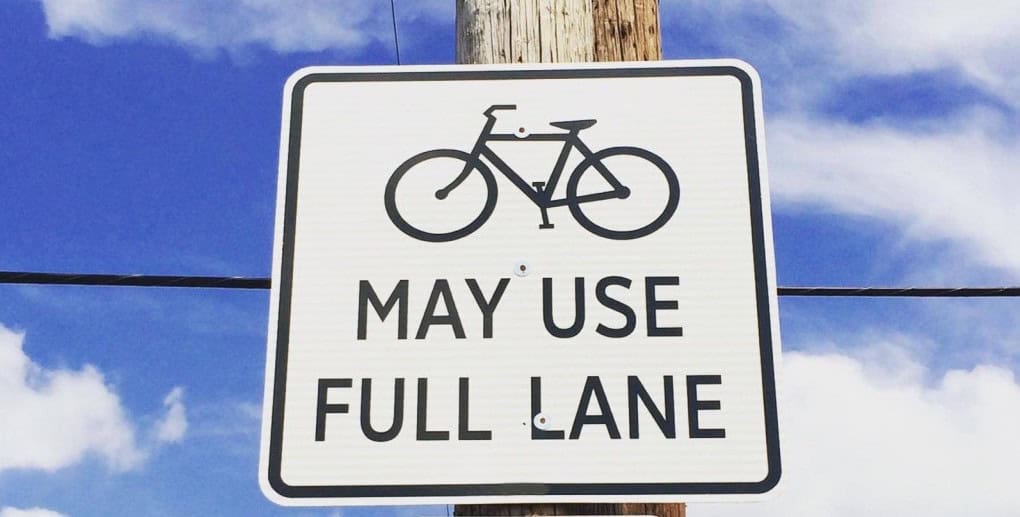
The state’s highest court weighs whether bicyclists, or police, can determine the safest lane position for you to ride
In July of 2021, Brendan Linton was riding on Evans City Rd, a two-lane road in Butler Township, when a police officer pulled him over. The cop claimed that Mr. Linton was impeding traffic and issued him a ticket.
However, Mr. Linton disagrees, and says that he was riding within the rules of the road according to Title 75, the PA Vehicle Code. The police officer, and now the state, claim that he should have pulled over into the shoulder to allow faster moving vehicles to pass, while Linton says that the shoulder was unsafe to ride in and that there was opportunity for vehicles to pass him as he took the lane.
Linton decided to challenge the ticket, losing at the local level, but through a series of appeals to higher courts, has ended up with an argument in front of the PA Supreme Court. Depending on how the state’s highest court rules, this ticket for a minor traffic violation has the potential to affect bicyclists across the Commonwealth of Pennsylvania.
The heart of the case involves whether a person riding a bicycle can determine the best lane position in order to stay safe, or if that decision is up to a police officer. Taken to a logical end, basically: Are bicyclists required to pull off the road to allow motor vehicles to pass? This then begs the question as to why legislators have already included language allowing drivers to pass in no passing zones, if bicyclists aren’t allowed to choose their safest lane position, even if that means riding in the travel lane.
Section § 3301(c) of the PA Vehicle Code, “Vehicle proceeding at less than normal speed,” states that “any pedalcycle . . . proceeding at less than the normal speed of traffic at the time and place and under the conditions then existing shall be driven in the right-hand lane then available for traffic, or as close as practicable to the right-hand curb or edge of the roadway (emphasis added).”
Our position is pretty clear – the person on the saddle of a bicycle is best equipped to make the decision to ride where they feel safest, and this seems to be backed up in the PA Vehicle Code by the inclusion of the word “or” within the guidance. There are many factors that go into lane position while riding a bike that someone driving a motor vehicle may not even notice, such as debris, cracks, potholes, parked cars, and a door zone, among other hazards.
Additionally, the Pennsylvania Bicycle Driver’s Manual, a PennDOT publication, seems to agree.
The PA Bicycle Driver’s Manual provides the following guidance:
Normally, slower traffic keeps to the right, and faster traffic passes on the left. Since your bicycle is usually slower than other traffic, you usually ride near the right edge of the road. However, how far to the right? Generally, the usable width of the road begins where you can ride without increased danger of falls, jolts, or blowouts. A road may have a gravel shoulder, its edge may be covered with sand or trash, or the pavement may be broken. Do not ride there. Closer to the Center, there is better pavement, which is swept clean of sand and debris by passing cars. The right side of the road begins there.
A ruling in favor of upholding the ticket may have broad unintended consequences and affect bicycling across the state.

On the lead up to the PA Supreme Court Hearing on October 10, BikePGH wrote and submitted an Amicus Brief to explain to the court how a ruling leaving the decision of lane position up to a police officer could affect our events, education, and advocacy efforts – the core of what we do. The League of American Bicyclists also contributed to the brief to show how PA’s current legislation compares to other states, and how Pennsylvania’s existing law regarding lane placement is the right approach.
Our brief emphasizes that the lower court’s interpretation of this statute is in conflict with PennDOT guidelines, creates a higher risk of harm to cyclists and drivers, and goes against long standing best practices found in bicyclist educational programming and community safety guidelines. Additionally, changing precedent will add confusion to behavior on the streets, and can result in more bicyclists getting pulled over, and cited, without justification. A ruling maintaining the status quo will help solidify our rights to the road to both drivers and law enforcement.
We were in attendance during the hearing to listen to both sides as they presented their argument to the justices in Downtown Pittsburgh. While it’s impossible to know how they will vote, it appeared to us, based on their line of questioning, that the judges were more sympathetic to the bicyclist’s argument than the state’s.
We won’t know the results until next year, likely in the spring. Needless to say, if they rule in favor of upholding Linton’s moving violation, there will be a question of whether we can ride where we feel the most safe, or if our lane position and ability to ride predictably will be determined by someone else – driving in a separate vehicle, who may not be aware of the hazards we are avoiding, nor the legal backing that we currently depend on. Changing the long established position on this sets a dangerous precedent for Pennsylvania bicyclists.